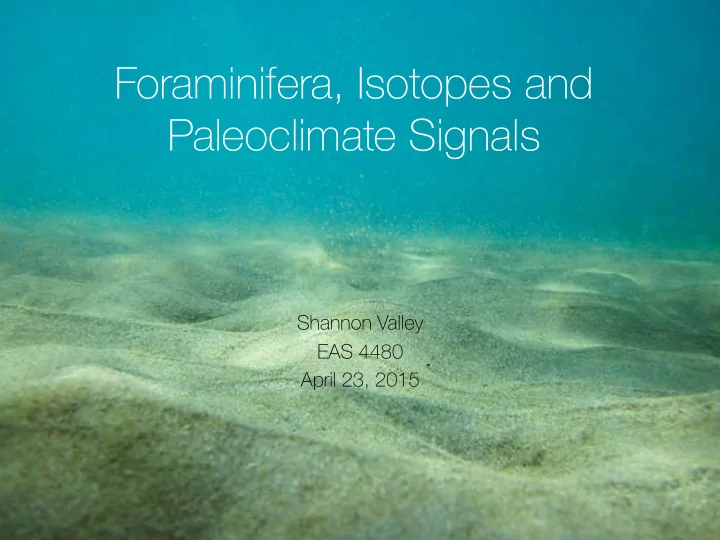

Foraminifera, Isotopes and Paleoclimate Signals Shannon Valley EAS 4480 April 23, 2015
What are foraminifera?
…and what can they tell us?
Isotope Ratios δ 18 O in forams: # T, $ δ 18 O δ 13 C in forams: # productivity, $ δ 13 C
Data and Methods Core KNR 166-2 JPC 26 from the Florida Straits 3 benthic foram species: Cibicidoides pachyderma Planulina ariminesis Cibicides mollis Data include depth/age model, δ 18 O and δ 13 C Analyses: Linear Regression Correlation Coe ffi cient Residual Analysis Polynomial Fits Time Series Analysis Is there a relationship between temperature and productivity evident in these species? Can we see evidence of past glaciations?
Linear Regressions with Error Bounds P ariminesis C mollis 2.2 1.8 1.6 2 1.4 1.8 1.2 1.6 1 1.4 0.8 1.2 0.6 1 0.4 0.8 0.2 0.6 0 0.8 1 1.2 1.4 1.6 1.8 2 2.2 2.4 2.6 1.3 1.4 1.5 1.6 1.7 1.8 1.9 2 2.1 2.2 2.3 C pachyderma 2 1.5 1 0.5 0 -0.5 0.5 1 1.5 2 2.5
Correlating productivity and temperature 1.8 1.7 Species Corr. Coef. 1.6 P . ariminesis 0.6272 1.5 C. mollis 0.4918 1.4 C. pachyderma 0.5742 1.3 1.2 1.1 1 0.9 0.8 0.8 1 1.2 1.4 1.6 1.8 2 2.2 2.4 2.6
Residual Analysis 1 st order– P ariminensis 1.8 Critical value Χ 2 value 1.6 1.4 21.03 173.2 1.2 1 0.8 0.8 1 1.2 1.4 1.6 1.8 2 2.2 2.4 2.6 P arimenisis Regression Residual Distribution 70 0.8 0.6 60 0.4 Residual 50 0.2 0 40 -0.2 -0.4 30 -0.6 0.8 1 1.2 1.4 1.6 1.8 2 2.2 2.4 2.6 20 10 0 -0.6 -0.4 -0.2 0 0.2 0.4 0.6 0.8
2 nd Degree Polynomial Fits P ariminesis P ariminesis 2 0.8 1.8 0.6 1.6 0.4 1.4 0.2 1.2 1 0 0.8 -0.2 0.6 -0.4 0.4 0.2 -0.6 0.8 1 1.2 1.4 1.6 1.8 2 2.2 2.4 2.6 0.8 1 1.2 1.4 1.6 1.8 2 2.2 2.4 2.6 C mollis C mollis 1.8 0.6 1.6 0.4 1.4 0.2 1.2 1 0 0.8 -0.2 0.6 0.4 -0.4 0.2 -0.6 0 -0.8 -0.2 1.3 1.4 1.5 1.6 1.7 1.8 1.9 2 2.1 2.2 2.3 1.3 1.4 1.5 1.6 1.7 1.8 1.9 2 2.1 2.2 2.3
2 nd Degree Polynomial Fits ¡ C pachyderma C pachyderma 2 0.8 1.8 0.6 1.6 0.4 1.4 0.2 1.2 0 1 0.8 -0.2 0.6 -0.4 0.4 -0.6 0.2 -0.8 0 0.5 1 1.5 2 2.5 0.5 1 1.5 2 2.5
P ariminesis Time Series 2.6 1.8 2.4 1.6 2.2 2 1.4 1.8 1.2 1.6 1.4 1 1.2 0.8 1 0.8 0.6 0 0.5 1 1.5 2 2.5 3 3.5 0 0.5 1 1.5 2 2.5 3 3.5 Age (yr BP) # 10 4 Age (yr BP) # 10 4 Power Spectrum for #; hifac=2; ofac=4. 20 18 16 14 Significant Periodicities (Yrs) p = 0.001 12 p = 0.005 Power p = 0.01 10 17,173 4293 3523 p = 0.05 δ 18 O p = 0.1 8 δ 13 C p = 0.5 22,898 10,568 4432 6 4 2 0 0 1 2 3 4 5 6 7 8 # 10 -3 Frequency (Hz)
C mollis Time Series 2.3 1.6 2.2 1.4 2.1 2 1.2 1.9 ?18O? ?13C? 1.8 1 1.7 0.8 1.6 1.5 0.6 1.4 1.3 0.4 1 1.5 2 2.5 3 3.5 1 1.5 2 2.5 3 3.5 Age (yr BP) # 10 4 Age (yr BP) # 10 4 p = 0.1 Power Spectrum for #; hifac=2; ofac=4. 6 p = 0.5 5 4 Significant Periodicities (Yrs) Power 3 - - - δ 18 O 2 δ 13 C 29,623 9875 6348 1 0 0 0.5 1 1.5 2 2.5 Frequency (Hz) # 10 -3
C Pachyderma Time Series 2.5 1.8 1.6 1.4 2 1.2 1 ?18O? ?13C? 1.5 0.8 0.6 1 0.4 0.2 0.5 0 0 0.5 1 1.5 2 2.5 3 3.5 0 0.5 1 1.5 2 2.5 3 3.5 Age (yr BP) # 10 4 Age (yr BP) # 10 4 Power Spectrum for #; hifac=2; ofac=4. Significant Periodicities (Yrs) 50 27,459 11,441 7268 5492 4291 3520 2214 1807 δ 18 O 40 δ 13 C 27,459 7226 5492 2921 - - - - Power 30 20 p = 0.001 p = 0.005 p = 0.01 10 p = 0.05 p = 0.1 p = 0.5 0 0 0.001 0.002 0.003 0.004 0.005 0.006 0.007 0.008 0.009 0.01 Frequency (Hz)
Conclusions, Questions Temperature is not shown to be an indicator of productivity using these isotopes for these species. Why? Time series analyses using these methods are inconclusive. Records are too short for known periodicities. Are the three species saying the same thing? Interpolation for cpsd / cross spectral analysis may cause aliasing/ spectral leakage.
Recommend
More recommend